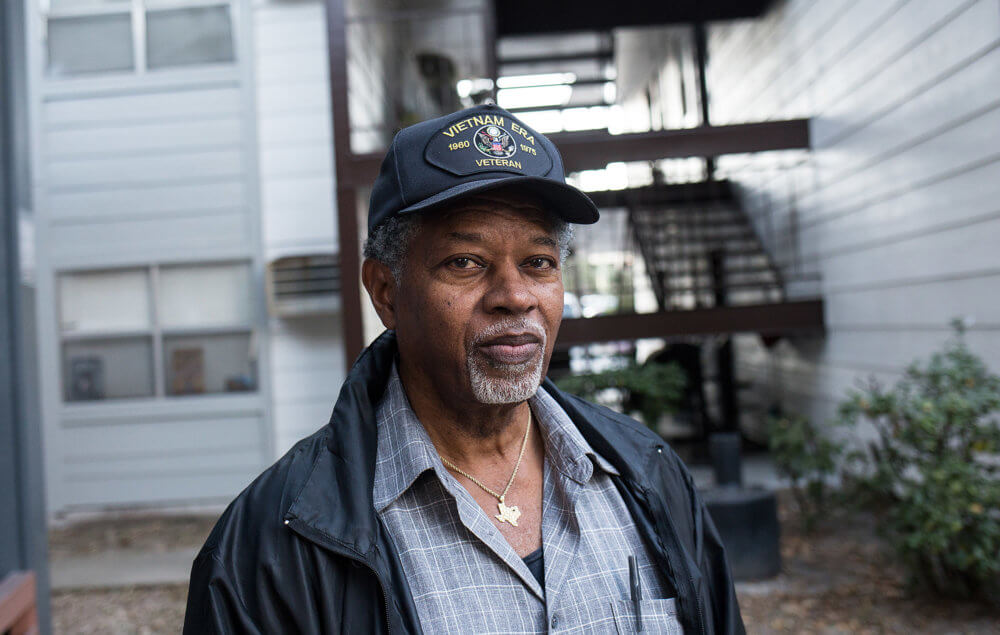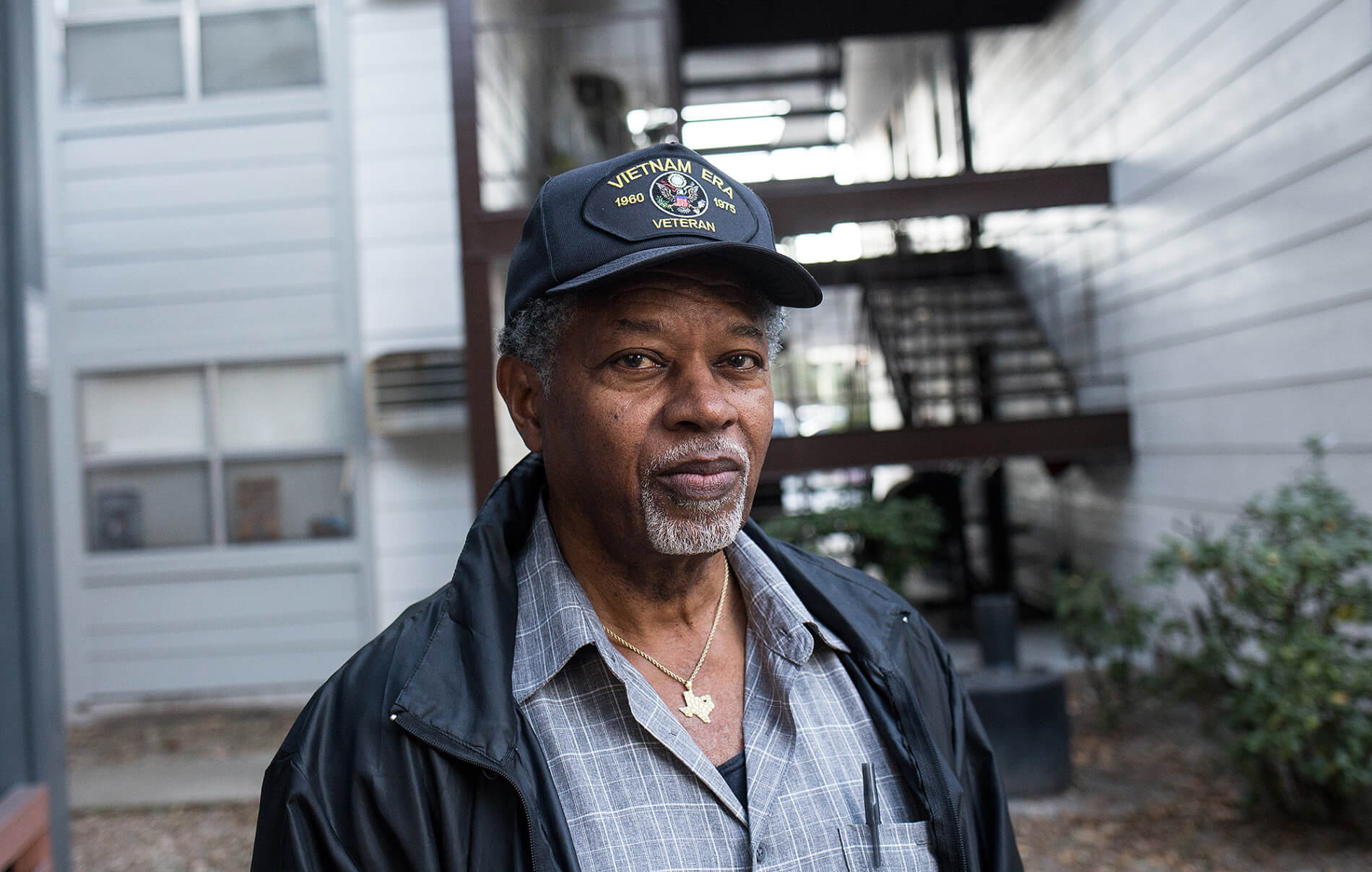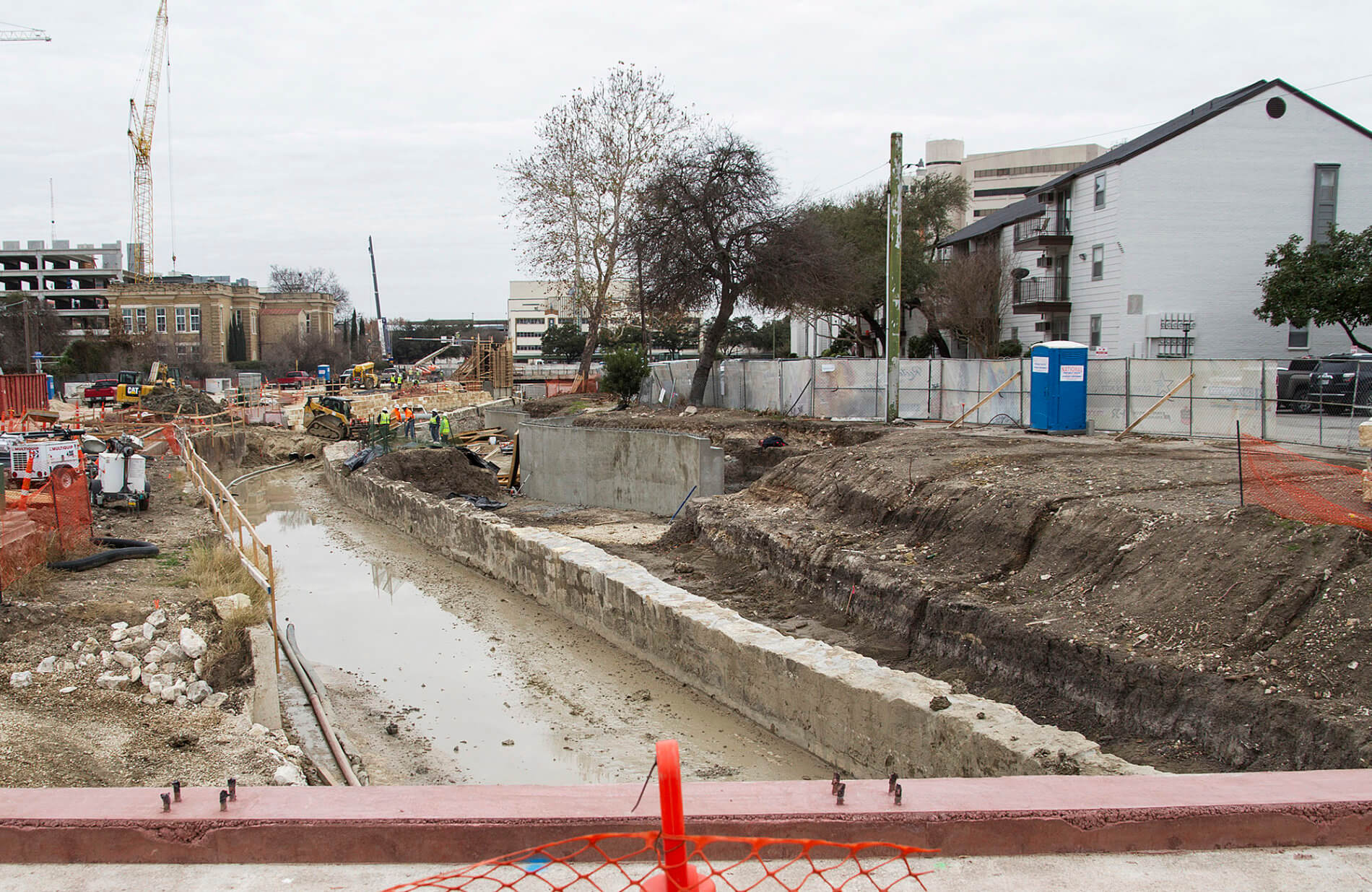

The $175 million transformation of San Pedro Creek, the channel that winds through the western half of downtown, is beginning to threaten the affordability of the two Soapworks properties and the neighboring Towne Center complex — all of which abut the creek. Led by Bexar County, the massive public project will revive what has been a decades-long dried-up ditch into something like the next River Walk.

In October, the Soapworks apartments were purchased by the Barvin Group of Houston. Lynda M. Gonzalez | Folo Media
About a year into construction, which began late 2016, Dawson wasn’t too worried. But in October, when a Houston-based investment group bought Soapworks and Towne Center, and immediately began renovating them, he became frightened.
The apartments “needed a fixup, but what they are trying to do is not that,” Dawson said over the incessant cacophony of downtown traffic and nearby construction vehicles. “We all think that they are trying to push us out.”
Dawson feels the renovations, the likes of which he hasn’t seen in the 38 years he’s lived there, are less for him and his current neighbors, and more for attracting higher-paying tenants, improvements for others to enjoy. Dawson’s rent has not yet increased, but empty units that are renovated are being offered at much higher rates than current residents pay.
Dawson, for example, pays 76 cents per square foot, but some of the renovated units are being advertised as high as $1.63 per square foot on the properties’ website.
Many of the residents of Soapworks and Towne Center — which combine for 381 units — are low-income, elderly or disabled, and some walk to their service industry jobs downtown. They believe the owners, the Barvin Group, are trying to capitalize on the San Pedro Creek project, which is expected to draw major investment from housing developers and other private sector players, just as the Museum Reach, another urban ditch turned linear park funded by public dollars, helped catalyze the Pearl.
Even if the Barvin Group doesn’t push out current residents for more immediate profits, residents worry that increasing property values in the area will leave them no choice. (The Barvin Group did not respond to requests for comment.) Some residents have already left on their own.
Some don’t expect to be around for San Pedro Creek’s grand opening, currently scheduled for May 5.
While San Antonio is already strapped for affordable housing — 153,000 units are needed, by last estimate — and while Mayor Ron Nirenberg has recently expressed his desire for affordable housing to be included in downtown development henceforth, what happens when some of the last existing affordable stock in a community is endangered by continued efforts to revitalize that very community?

Soapworks and Towne Center occupy three corners of the West Martin and South Santa Rosa intersection and offer some of the last affordable housing units left in a fast-gentrifying downtown.
The way some residents see it: because city and county policies are the driving force behind all of downtown’s recent and potential growth, shouldn’t it be the city and county’s responsibility to offset potential damage to long-term and vulnerable residents?
As San Antonio’s center continues to grow with the help of public money, this dilemma plays on repeat. Specifically, major transformations of segments of the San Antonio River — the Museum Reach to the north, the Mission Reach to the south — have had an impact on communities built along the waterway.
During the late 2000s, when the Museum Reach was completed, a handful of residents and organizations along that portion of the San Antonio River were displaced as development moved in and property values rose. In 2014, 300 residents were uprooted from the Mission Trails mobile home park along the Mission Reach to the south to make room for a luxury complex.
“Not having housing security is literally debilitating on the brain and on the body.” — Maureen Galinda, Soapworks resident
Recently, to help curb this trend while simultaneously addressing downtown’s lack of affordability, Nirenberg placed a moratorium on a downtown incentives program known as the Center City Housing Incentives Policy. Also, Nirenberg’s housing task force is currently meeting to solve dilemmas like Soapworks and Towne Center.
“We created the Mayor’s Housing Policy Task Force to address issues just like this one,” Nirenberg said in a statement to Folo Media. “Understanding that the challenges of growth and development are complex, we expect the Task Force to deliver a set of compassionate policy recommendations that would help us ensure that affordable housing stock exists throughout our city and that our residents can age in place.”
A 2013 economic impact report predicted that in its first 10 years, the San Pedro Creek project would bring in 7,300 new residents to the area, increase property values by 150 percent and draw in $227 million in ad valorem tax revenue.
Though Dawson and other residents like where they are living, most just want to move — if they can afford to.
A handful of tenants have approached District 1 Councilman Roberto Treviño to request financial help with a move.
Treviño met with the San Antonio Housing Authority and the Department of Human Services on Friday, Jan. 13, to discuss the situation. Treviño said he will find a way to get moving assistance for any resident that is priced out.
“My goal is to help them however they want me to,” Treviño said. “I want to help them if they want to stay or if they want to leave … that is their choice.”
Treviño said he is still analyzing how he can help residents stay if their rent increases dramatically, but so far no one who has approached him has wanted to stay.
Bexar County Judge Nelson Wolff said county officials have not discussed the situation at Soapworks and Towne Center, nor has he heard complaints from its residents. However, he said the county will not allow a scenario like Mission Trails to happen again.
“It is one thing when residents are being displaced, but that is not what is happening here,” Wolff said.

Most residents describe their relationship with the new owners as shaky. At best, they feel management isn’t worrying about them because they’re so focused on the upgrades. At worst, they feel management is intentionally being difficult and uncommunicative in an attempt to drive them out.
Several residents, Dawson included, say management has not explained to them how the price increase will occur. They see their floor plans listed online for significantly more than they are currently paying, and thus they worry. Dawson currently pays $746 a month for his three-bedroom, 972-square-foot apartment, but on the Soapworks website, it’s listed at $1,350.
Michelle McMillan, a representative of Capstone Real Estate Services, Inc., said they intend to create “middle-income housing” at Soapworks and Towne Center. Residents will not be forced out by management or intentionally priced out, she said.
Instead, rent will only be raised on units once they are rehabbed, she said. They will not begin the renovations while someone is living in a unit, nor will they ask residents to leave so they can renovate, she said. McMillan said Capstone will work with an apartment locator service to identify affordable properties in the area for residents who want to leave.
In two or three years, McMillan expects all of the apartments at Soapworks and Towne Center will have been renovated, meaning they will all be rented at the higher rates quoted on the website.
The residents Folo Media interviewed — seven, in all — had not heard these terms.
The current lease terms offered at the properties range from four to nine months, exacerbating fears among the residents that they will be kicked out around the time renovations along the San Pedro Creek are finished in May.
Maureen Galindo, 30, a single mother of three children — ages 1, 5 and 7 — lease expires in February, and she expects to be offered a four-month renewal. She worries Capstone will push her and her kids out after the four months are up, or raise her rent in retaliation for her vocal opposition. Others fear retaliation for speaking out as well.
“Not having housing security is literally debilitating on the brain and on the body,” Galindo said.
“I’m going through that once again, as well as all of our neighbors. It’s bad from a moral viewpoint and also from an economic (viewpoint). You can’t just kick people out on the streets.”
“I feel like they are hitting us with a wooden knife. It’s enough to hurt, but not make us bleed.”
anonymous Soapworks resident
McMillan said Capstone does not consider these leases to be short-term because they offer the same terms at other properties they manage. She also said residents will be able to extend their contract for the same price when the current lease expires.
All of the residents Folo Media interviewed complained about how management has treated them, from expired fire extinguishers, to missing rent statements, to faulty water heaters. Residents say Capstone won’t accept $1 bills for washing machines tokens, only $5. And when the machines eat the tokens, the management won’t refund the lost coins, the residents say.
“I feel like they are hitting us with a wooden knife,” said a Soapworks resident who wished to remain anonymous. “It’s enough to hurt, but not make us bleed.”
McMillan denies that management is trying to force out residents under the table. She claims most of the residents have not voiced their concerns to the staff, and insists the staff would assist them if they did so.
She also added that management has not looked at the incomes of any of the current residents, but that many of them will possibly be able to afford updated units. According to the website, the new prices for Soapworks and Towne Center range from $1.35 to $1.63 per square foot, which is nowhere near the $2 per square foot offered at complexes in and near the Pearl or even higher luxury apartment rates cropping up elsewhere, such as the $3.14 per square foot at the Cellars in the Pearl.
Even if some of the rumors floating among the residents are false, their fear represents a very real concern about the availability of affordable housing along the San Pedro Creek as the renovations go forward.
The residents are planning to meet soon to discuss what is happening and what needs to be done. For now, they say, all they can do is wait.
“Everybody sort of just feels clueless in that realm,” Galindo said. “I just bring it up to people, outside, walking around, ‘How do you feel about everything?’ They say, ‘I don’t know, I don’t know what’s going on.’”
This article was originally published by the H.E. Butt Foundation’s Folo Media initiative in 2017.